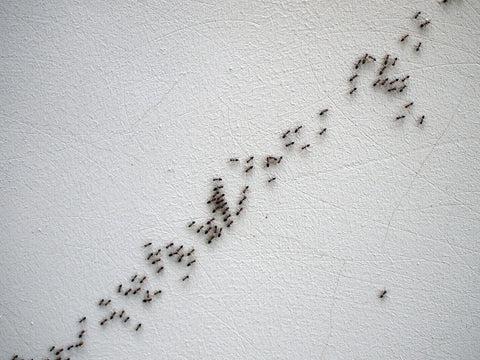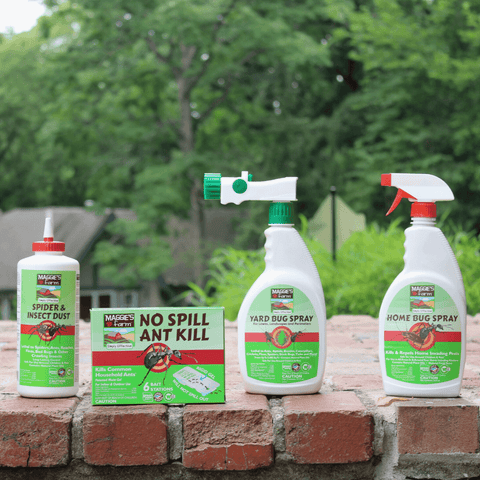As their name suggests, little black ants (Monomorium minimum) are smaller than other ant species. These ants are relatively harmless, but they can be a nuisance. They have no problem crawling all over you sandwich. Check out how you can identify and eliminate a little black ant infestation.
How do You Identify Little Black Ants?

Little black ants range from dark brown to black in color. They appear shiny and measure about 1/16ʺ in length. Queens are larger, measuring about 1/8ʺ. Their antennae have twelve segments.
Where Can You Find Little Black Ants?
Little black ants are found throughout the United States, more highly concentrated in urban and industrial areas. Little black ants live both outdoors and indoors. They prefer to be outside in areas that are dark and protected. You can find them nesting in soil or under yard debris like rocks and logs. These pests use cracks and crevices to enter homes. If they make their way inside, they’ll look for undisturbed locations including behind baseboards and in wall voids.
What Do Little Black Ants Eat?
Little black ants have quite an appetite, and they’ll eat just about anything they can find. Your leftovers can become their next meal, so don’t be surprised if you see ants marching on your kitchen counters and in your pantry. These ants eat meat, greasy food, seeds, insects, and sweets. They’re especially fond of honeydew, which aphids produce. Ants will actually protect aphids in order to harvest the honeydew they secrete. They aren’t afraid to pick a fight with other insects if their food source is threatened.
How Did Little Black Ants Get Into My Home?
Read more : What Size Trash Can for Kitchen Is Best?
Little black ants come indoors at times in search of food and moisture, and an infestation of these little pests is typically the result of improper food storage. Noticing these ants in your home may mean a larger outdoor infestation is at hand and located nearby, or possibly already inside.
Do You Have a Little Black Ant Infestation?
The main sign of an infestation is spotting ants. Even if their nest is outside, they could still be invading your house. These ants enter homes searching for food and water. It’s common to find their trails in kitchens and bathrooms. Check areas where moisture or food can accumulate including cabinets, sinks, and counters.
How Serious is a Little Black Ant Problem?
These ants often live in colonies with more than one queen. This can result in large colonies and infestations. They also leave pheromone trails, which can lead ants right to your home. You’ll likely see these trails on the walls of your home and sidewalks. These ants do have stingers, but because of how small they are, it won’t cause any harm to you. They will mostly get on your nerves and make you not want to eat your food if they succeed in getting to it in large numbers. Note that they do crawl over everything they can, making them carriers of bacteria.
How Do You Prevent Little Black Ants?

The best way to keep little black ants away is to make your home as unwelcoming as possible. Here are a few tips to help you prevent an infestation.
- Keep your sink free of dirty dishes
- Keep your trash sealed and take it out regularly
- Sweep, mop, vacuum regularly
- Caulk and seal gaps, cracks, and holes in exterior walls to keep little black ants from getting inside.
- Outdoors, remove firewood and any other yard debris away from the side of your home.
- Landscaping mulch shouldn’t be more than two inches thick, and should be kept at least 12 inches away from your home’s foundation.
- Avoid sprinklers from spraying the side of your home/foundation whenever possible.
- Keep the lawn mowed and trees/shrubs trimmed away from touching the side of your home.
- Treat plants for aphids regularly.
How Do You Get Rid of Little Black Ants?

Read more : Yahoo Sports
When dealing with an ant problem, you need to eliminate the source of the infestation or these pests will keep coming back. Ant baits can help with this task.
Baits
Ant baits are designed to allow ants to eat the bait and carry it back to the nest. This helps ensure the entire colony will be eliminated and not just the ants you see. Our No Spill Ant Kill bait stations and our Ant Killer gel bait can be used outside and in your home, without the mess of other liquid baits. Place the bait near trailing ants. This will help to prevent them from finding an alternative food source. If you can find the nest, you can also place bait near it. Make sure to remove any other food sources, like crumbs, so the ants eat the bait. You’ll also want to avoid spraying insecticides with residual repellency near the bait. This will deter ants from going near the bait.
Sprays
Sprays are another option when dealing with ants. They can be used indoors and outside. They work well as a spot treatment for the little black ants you see. Our Ant & Roach Killer spray contains natural plant oils. It kills ants on contact and provides residual repellency. Sprays work best when only a few ants are invading your home.
Our Yard Bug Spray can be used around the perimeter of your yard and house. The residual repellency acts as a barrier helping to keep ants from getting inside your home. It also kills ants on contact.
Dusts
Dusts also work well as an ant contact killer, if you can find the colony/nest. Try Maggie’s Farm Spider & Insect Dust. For Little Black ants, CAREFULLY puff dust into wall voids where you might suspect a nest. Repeat a few days later if there is still ant activity.
For scientifically-tested, effective ant control in your home, yard, and garden that is friendly to the environment, try Maggie’s Farm pest control products. Our promise is that our plant and mineral-based products are developed by scientists and seasoned pest control professionals to be the most effective.
Source: https://gardencourte.com
Categories: Kitchens
